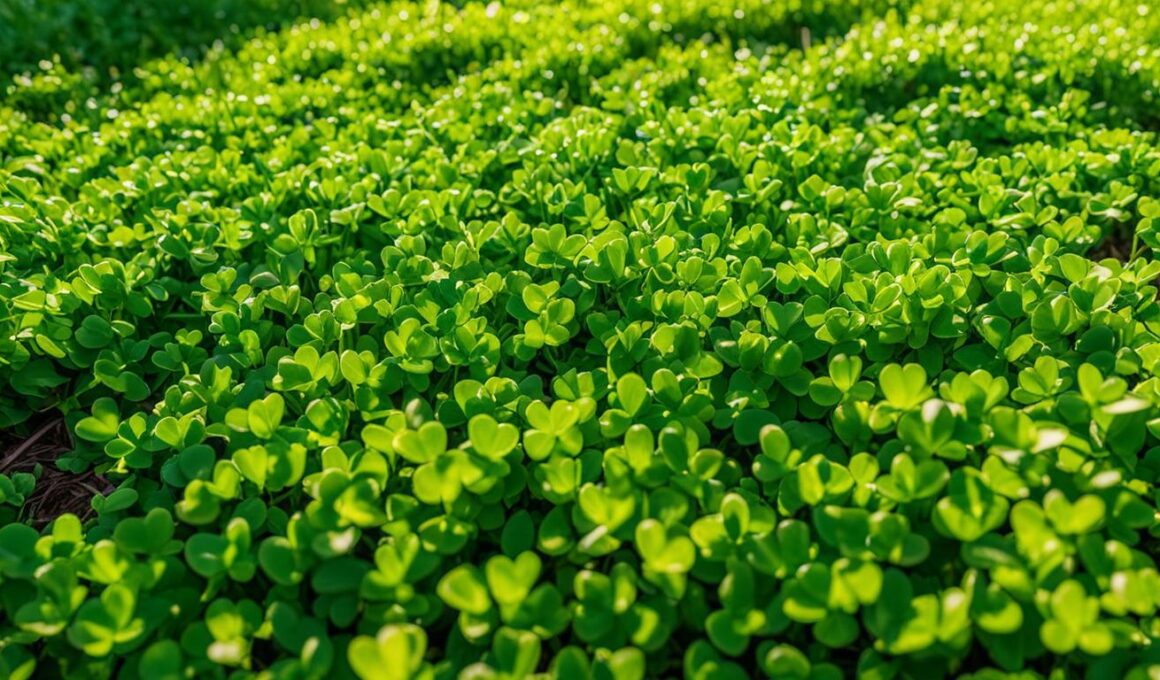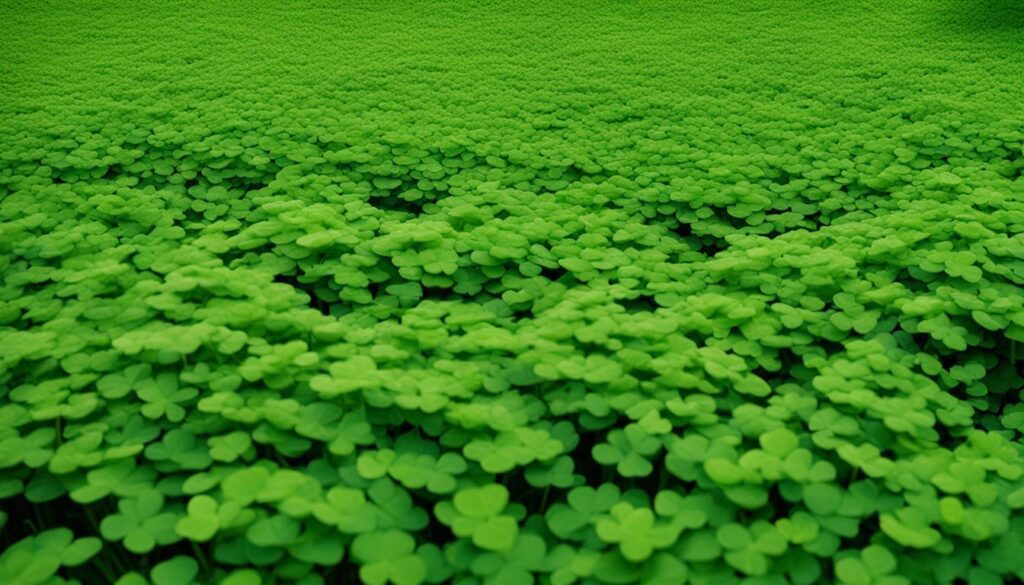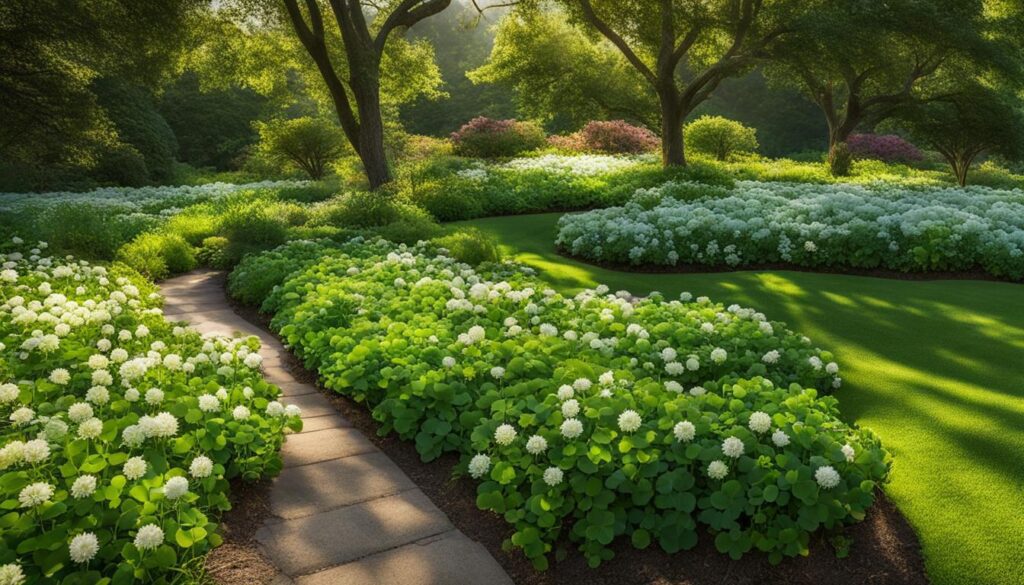Are you tired of spending hours maintaining your traditional grass lawn? Looking for a more eco-friendly and low-maintenance alternative? Consider a micro clover lawn. Micro clover is gaining popularity among homeowners who want a lush and beautiful lawn without the hassle and environmental impact of traditional turfgrass.
Much more than just a weed, clover has several benefits that make it an excellent choice for your lawn. It can fix nitrogen in the soil, providing a natural source of fertilizer for itself and surrounding plants. It requires less water, is heat-tolerant, and suppresses weeds without the need for herbicides or pesticides.
Whether you choose to grow a single-species micro clover lawn or mix it with traditional grass, your yard will be greener, more eco-friendly, and easier to maintain. Say goodbye to constant mowing, watering, and fertilizing, and say hello to a beautiful micro clover lawn.
Key Takeaways:
- Micro clover is an eco-friendly alternative to traditional grass lawns.
- It requires less water, fertilization, and mowing, making it low-maintenance.
- Clover lawns are heat-tolerant and suppress weeds naturally.
- You can choose to have a single-species micro clover lawn or mix it with traditional grass.
- Micro clover lawns are a greener and more sustainable option for your outdoor space.
Benefits of a Micro Clover Lawn
A micro clover lawn offers several advantages compared to traditional grass lawns. It is a low-maintenance, water-saving, and heat-tolerant option that is also eco-friendly.
One of the key benefits of a micro clover lawn is its low water requirements. Clover is naturally more drought-tolerant than turfgrass, meaning you can save water and still enjoy a lush, green lawn.
Another advantage is the reduced need for mowing. Unlike traditional grass lawns that require frequent cutting, micro clover grows at a slower rate and doesn’t need to be mowed as often. This saves you time and effort on lawn maintenance.
In addition to its water-saving and low-maintenance qualities, micro clover is also heat-tolerant. It stays green and vibrant even during the hot summer months, when traditional grass lawns can struggle to survive.
Furthermore, a micro clover lawn is a more eco-friendly choice. It doesn’t require frequent applications of fertilizers because it can fix nitrogen for itself and surrounding plants. This natural fertilization process helps improve soil health and reduces the need for chemical fertilizers.
Clover is also effective at suppressing weeds and preventing pests, reducing the need for herbicides or pesticides. This makes it a safer and healthier option for your lawn.
Lastly, micro clover seed is inexpensive compared to grass seed, making it a cost-effective choice for homeowners looking to establish or renovate their lawns.
With its low-maintenance nature, water-saving capabilities, heat tolerance, and eco-friendly qualities, a micro clover lawn offers a range of benefits for homeowners who want a beautiful and sustainable outdoor space.
Types of Clover for Your Lawn
When choosing clover for your lawn, there are several varieties to consider. White clover is the most well-known and is a low-growing, rapid spreader that outcompetes weeds. It forms dense mats of foliage and is highly durable, making it perfect for high-traffic areas. White clover also attracts pollinators like bees and butterflies, contributing to a thriving ecosystem.
Red clover is another popular choice for lawns. It features pretty reddish-purple flowers that add color and interest to your landscape. Red clover is taller than white clover and adapts well to a variety of soil conditions. It is often grown as a cover crop due to its nitrogen-fixing abilities, enriching the soil and benefiting surrounding plants.
A newer cultivar of white clover, microclover, has gained popularity for its smaller leaves and fewer flowers. It grows lower to the ground, giving your lawn a uniform and carpet-like appearance. Microclover integrates well with other grasses and blends seamlessly into a variety of turfgrasses. This variety requires less mowing and maintenance, making it an ideal addition to a low-maintenance lawn.
For a blended lawn with clover and grass, recommended pairings include different grass species such as fescues, ryegrass, or Bermuda grass. These combinations create a harmonious and attractive landscape, combining the benefits of both clover and grass. The mix of clover and grass provides a resilient and lush lawn that requires less water, fertilizer, and overall maintenance.
Planting and Establishing a Clover Lawn
Creating a lush and vibrant clover lawn requires proper establishment. Follow these steps to successfully plant and establish a clover lawn in your outdoor space.
Clearing and Preparing the Area
Before planting clover, start by clearing the area of any existing grass, weeds, rocks, and debris. This ensures a clean and nutrient-rich space for your new clover lawn to thrive. Take the time to remove any unwanted vegetation to prevent competition and provide a fresh start for your clover seeds.
Checking and Adjusting the Soil pH
Once the area is cleared, it’s important to check the soil pH. Clover prefers a slightly acidic to neutral pH level ranging from 6.0 to 7.0. If the soil pH is outside this optimal range, adjustments may be necessary. Test the soil using a pH testing kit and make any required amendments to bring it within the desired range.
Spreading Clover Seeds and Ensuring Good Contact
After preparing the soil, evenly spread clover seeds over the entire area. Use a broadcast spreader or hand spreader to achieve an even distribution. Once the seeds are spread, lightly rake the soil to ensure good seed-to-soil contact. This will help facilitate germination and establish a strong connection between the seeds and the soil.
Thoroughly Watering and Maintaining Moisture
The next step in establishing a clover lawn is to thoroughly water the area immediately after seeding. Water helps to settle the seeds into the soil and initiate the germination process. Ensure that the area is properly saturated, providing enough moisture for the seeds to germinate. After initial watering, it’s important to keep the area consistently moist until germination occurs.
Germination and Daily Care
Clover typically germinates within a week under optimal conditions. During this period, it’s important to provide daily misting or light watering to keep the surface of the soil moist. This helps create an ideal environment for seed germination. Once the clover seeds have germinated, continue to monitor soil moisture and adjust watering as needed.
Reseeding for Mixed Lawns
If you’re establishing a mixed lawn with both clover and grass, consider reseeding with clover seeds in the fall instead of using grass seeds. This allows the clover to establish and fill in any bare areas, creating a seamless blend between the clover and grass.
By following these steps, you can successfully plant and establish a clover lawn in your outdoor space. With proper care and maintenance, your clover lawn will thrive, providing an eco-friendly and beautiful alternative to traditional grass lawns.
Maintaining a Clover Lawn
Once your clover lawn is established, you’ll be delighted to find that it requires minimal maintenance. Here are some essential tips to keep your clover lawn in top shape:
Optimal Sun and Shade
A clover lawn performs best in full to part sun, but it can also tolerate some shade. Ensure that your lawn receives adequate sunlight for healthy growth.
Watering
When first establishing your clover lawn, watering may be more frequent. However, once it’s established, it only needs to be watered once or twice a week, depending on the weather and rainfall. Clover has good drought tolerance and can withstand periods without rain.
Soil Conditions
One of the advantages of clover is its adaptability to various soil conditions. It can thrive in compacted or poorly drained soil, making it a versatile choice for different areas of your lawn.
Mowing Frequency
The mowing frequency of your clover lawn depends on your desired lawn look. Some homeowners prefer a neatly mowed appearance and mow their clover lawn regularly. Others choose to let the clover grow longer, giving it a more natural and meadow-like aesthetic.
Nitrogen-Fixing Properties
One of the incredible properties of clover is its ability to fix nitrogen in the soil. This means that you won’t need to fertilize your clover lawn frequently. The nitrogen produced by clover is beneficial to itself and surrounding plants, promoting healthy growth and greener foliage.
Pros and Cons of Clover Lawns
A clover lawn offers numerous benefits that make it an appealing choice for homeowners. First and foremost, clover lawns are known for their water-saving properties. Clover is more drought-tolerant than traditional turfgrass, meaning it requires less water to thrive. This not only helps conserve water resources but also reduces the amount of time and effort spent on watering.
Another advantage of clover lawns is their reduced maintenance requirements. Unlike grass lawns that need regular mowing, clover lawns grow at a slower rate and thus need less frequent mowing. This not only saves you time but also reduces noise pollution and fuel consumption from lawnmowers.
Furthermore, clover lawns exhibit excellent heat tolerance. While traditional grass lawns may turn brown and go dormant during hot summer months, clover remains green and vibrant. Its ability to withstand heat makes it an ideal choice for regions with high temperatures or limited access to water.
One of the most significant benefits of clover lawns is their eco-friendliness. Clover is a nitrogen-fixing plant, meaning it naturally enriches the soil by converting atmospheric nitrogen into a usable form. This reduces the need for chemical fertilizers and promotes healthier soil. Additionally, clover lawns attract beneficial insects like bees, butterflies, and other pollinators, contributing to the overall biodiversity of your yard.
However, like any landscaping option, there are a few downsides to consider. Clover lawns may not wear evenly under heavy foot traffic, which can result in uneven patches over time. If you have a highly active household or frequently host events in your yard, you may need to consider alternative options for high-traffic areas.
Another point to keep in mind is that some homeowner associations may have restrictions on clover lawns. Before transitioning to a clover lawn, it’s essential to check the guidelines and regulations set by your HOA or local authorities. Ensuring compliance with any required landscaping standards will help you avoid potential conflicts.
Additionally, for households with individuals who have bee sting allergies, planting a clover lawn may not be suitable. Bees are attracted to the flowers of clover plants, and the increased presence of bees can pose a potential risk for those with allergies.
Clover lawns have numerous benefits, including water savings, reduced maintenance, heat tolerance, and eco-friendliness. However, they may not wear evenly under heavy foot traffic, and some homeowner associations may have restrictions on clover lawns. If someone in the household has a bee sting allergy, planting a clover lawn may not be suitable.
Considering the pros and cons of clover lawns will help you make an informed decision about whether it’s the right choice for your lawn. With its numerous benefits, a clover lawn can provide you with an eco-friendly and low-maintenance alternative to traditional grass lawns.
Clover Varieties for Your Landscape
When incorporating clover into your landscape, you have several varieties to choose from. Each variety of clover has its own characteristics and ideal growing conditions, allowing you to select the one that best suits your needs and preferences.
Dutch White Clover
The most common variety of clover is Dutch white clover. This variety is quick-growing and can reach a height of 8 to 10 inches. It provides excellent coverage and can quickly spread to fill in bare areas of your lawn or landscape.
Micro Clover
If you prefer a smaller form of white clover, micro clover is an ideal choice. This variety has a dense growth habit and can tolerate low mowing heights, making it a great option for those who want a neat and tidy lawn. Micro clover is also known for its nitrogen-fixing ability, which helps to naturally fertilize nearby plants.
Red Clover
For those looking to add a pop of color to their landscape, red clover is a great option. This perennial herb features pretty reddish-purple flowers and can be grown in combination with other clover varieties or even turf grass. Red clover is a versatile choice that adds visual interest to your outdoor space.
By selecting the right variety of clover for your landscape, you can create a vibrant and sustainable environment. Consider the characteristics and ideal growing conditions of each variety to ensure success in cultivating a clover-filled landscape.
Conclusion
A micro clover lawn is an eco-friendly alternative to traditional grass lawns that offers numerous benefits. By opting for a micro clover lawn, you can contribute to water conservation efforts, as clover is more drought-tolerant than turfgrass. Additionally, you’ll enjoy reduced maintenance requirements, as clover lawns need less frequent mowing and don’t require extensive fertilization or aeration.
Not only does a micro clover lawn require less time and effort to maintain, but it also enhances the overall health of your soil. Clover’s ability to fix nitrogen provides a natural fertilizer boost to not only the clover itself but also to the surrounding plants. This promotes soil health and encourages lush, green growth throughout the year, even in hot and dry conditions.
With proper establishment and regular maintenance, a micro clover lawn can be a beautiful and sustainable addition to your outdoor space. However, it’s important to consider the pros and cons of clover lawns before making a decision. While they offer numerous benefits, such as improved soil health and eco-friendliness, they may not wear evenly under heavy foot traffic and could potentially be restricted in certain homeowner associations. Assess your needs and preferences to determine if a micro clover lawn is the right choice for you.
Will a Micro Clover Lawn Require Less Watering Than Traditional Grass Seed?
Yes, a micro clover lawn will require less watering new grass seed time than traditional grass seed. This is because micro clover has deeper roots that can access water from deeper in the soil, reducing the need for frequent watering.
FAQ
What are the benefits of a micro clover lawn?
A micro clover lawn offers several advantages compared to traditional grass lawns. It requires less water, needs less frequent mowing, and is more heat-tolerant. It also fixes nitrogen for itself and surrounding plants, suppresses weeds, prevents pests, and doesn’t require herbicides or pesticides.
What types of clover are suitable for a lawn?
The best types of clover for a lawn include white clover, red clover, and microclover. White clover is a low-growing, rapid spreader that outcompetes weeds. Red clover has pretty reddish-purple flowers and is taller than white clover. Microclover is a new cultivar of white clover with smaller leaves and fewer flowers.
How do I plant and establish a clover lawn?
To plant a clover lawn, clear the area and remove existing grass, weeds, rocks, and debris. Check the soil pH and adjust if necessary. Spread the clover seeds evenly over the soil and lightly rake them in for good contact. Water the area thoroughly and keep it moist until germination. Clover typically germinates within a week. For a mixed lawn, clover seeds can be reseeded in the fall instead of grass seeds.
How do I maintain a clover lawn?
Once established, a clover lawn requires minimal maintenance. It performs best in full to part sun but can tolerate some shade. Watering may be frequent initially, but it will only need to be watered once or twice a week in periods with no rain. Mowing frequency can vary based on the desired lawn look. Clover lawns do not need frequent fertilization or aeration due to the nitrogen-fixing properties of clover.
What are the pros and cons of clover lawns?
Clover lawns have numerous benefits, including water savings, reduced maintenance, heat tolerance, and eco-friendliness. They attract beneficial insects, prevent soil erosion, and improve soil health. However, clover lawns may not wear evenly under heavy foot traffic, and some homeowner associations may have restrictions on clover lawns. Additionally, if someone in the household has a bee sting allergy, planting a clover lawn may not be suitable.
What are the different varieties of clover for the landscape?
There are several varieties of clover to choose from when incorporating it into your landscape. Dutch white clover is the most common variety, quick-growing and reaching a height of 8 to 10 inches. Micro clover is a smaller form of white clover, with a dense growth habit and tolerance to low mowing. Red clover is a perennial herb that can be grown in combination with other clover varieties or turf grass.











